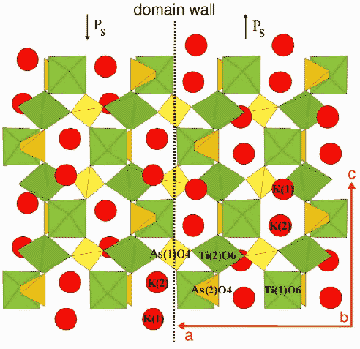- Home
- Users & Science
- Scientific Documentation
- ESRF Highlights
- ESRF Highlights 2000
- Microfocussing and Imaging
- Use of Bragg Diffraction Imaging, with a Coherent Beam, to Determine the Matching of Ferroelectric Domains
Use of Bragg Diffraction Imaging, with a Coherent Beam, to Determine the Matching of Ferroelectric Domains
It is well known that the structural arrangements found in domains, or twins, are usually related to each other via symmetry elements lost during the structural phase transition. However, almost nothing is known about how the domains are connected across the domain wall and, in particular, how they are matched at the atomic (structural) level. In symmetry terms, this is equivalent to locating the position of the lost symmetry element or the "origin" for the twinning operation, something that is particularly hard to do in polar crystals. This is because very few experimental techniques allow one to access this elusive microstructural information. The use of Bragg diffraction imaging (X-ray topography), with a coherent beam, is able to produce this detailed structural information, even though the spatial resolution of the images is on the much larger scale of micrometres.
'Periodically-poled' crystals contain periodically-spaced ferroelectric domains. The switching of the sense of Ps (the spontaneous polarisation vector) is associated with the inversion of the non-centrosymmetric crystal structure. Periodically-poled crystals are important materials for non-linear optical devices. However, they are generally difficult to produce, and the physical understanding of the features of the ferroelectric domain walls (twin boundaries) is essential for improvement of the processing. The comparison between the structural matching schemes found at "naturally-occurring" and "induced" domain walls is of particular interest.
Phase-sensitive Bragg diffraction imaging, with images recorded at various sample-to-detector distances, has already been used to investigate ferroelectric domains within a periodically poled lithium niobate crystal. Bragg diffraction introduces a phase-shift between the waves diffracted in adjacent domains, mainly because of the intrinsic phase difference ![]()
![]() between their structure factors. Fresnel diffraction determines the resulting intensity variations after free space propagation, which allows one to extract
between their structure factors. Fresnel diffraction determines the resulting intensity variations after free space propagation, which allows one to extract ![]()
![]() [1].
[1].
This approach is applied in the present work to a periodically poled KTA (KTiOAsO4) crystal to identify, through the quantitative analysis of the contrast as a function of propagation distance, the matching scheme for induced inversion domains. Five possible schemes, in which the inversion domains are matched through the atoms As(1), As(2), Ti(1), Ti(2) [2] and Ti(2)para (the position of the inversion centre in the paraelectric phase), are considered. Each of these matching schemes introduces a different phase shift in diffraction from adjacent domains and thus, it is possible to distinguish between them. The KTA sample was produced by a low-temperature poling method [3] at the Tel Aviv University, using a Z-cut wafer. The domain reversal, with 39 µm period, was performed across the whole 0.5 mm thickness of the sample. The domain walls were constrained by the poling mask to be normal to the [100] crystallographic direction. The experiments were performed at ID19.
 |
Fig. 105: Section topographs of a KTA sample as a function of the sample-to-detector distance D using the 1
|
Figure 105 shows white beam transmission section diffraction images, obtained with an incident beam restricted in one direction to 20 µm, which were recorded at various sample-to-detector distances. The simulations, shown below the experimental images, are generated taking the origin of the polar structure (space group Pna21) to be at As(1). The origin chosen corresponds to the best fit for all investigated reflections. These results clearly suggest that the As(1) atom is the linking or "pivot" atom for connecting the inversion domains across the wall. The corresponding model for the twinning is shown in Figure 106. It preserves the continuity of the major structural chains of As(1)O4-Ti(2)O6 polyhedra along [100] across the domain boundary.
 |
Fig. 106: Schematic view of a domain wall (dotted line) perpendicular to the a-axis passing through the atom As(1).
|
The application of Bragg-diffraction imaging with a highly coherent beam, of the ESRF, to elucidate previously-inaccessible structural information at domain boundaries in a periodically-poled ferroelectric, has been clearly demonstrated. This opens the way to a wide range of studies of domain structures in spatially-modulated crystals.
References
[1] P. Pernot-Rejmánková, P. Cloetens, J.-P. Guigay, J. Baruchel and P. Moretti, Phys. Rev. Lett. 81 (1998) 3435.
[2] P.A. Thomas and A.M. Glazer, J. Appl. Cryst. 24, 968-971 (1991).
[3] G. Rosenman, A. Skliar, D. Eger, M. Oron and M. Katz, Appl. Phys. Lett. 73 (1998) 3650.
Principal Publication and Authors
P. Pernot-Rejmánková (a), P.A. Thomas (b), P. Cloetens (a), F. Lorut (a), J. Baruchel (a), Z.W. Hu (b), P. Urenski (c) and G.Rosenman (c), J. Appl. Cryst. 33 (2000) 1149.
(a) ESRF
(b) University of Warwick, Coventry (UK)
(c) Tel Aviv University (Israel)



